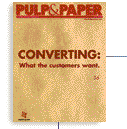
Filling the gap
Customers can be such a problem. They’re not always very likeable sorts. They tend to want a lot, and then aren’t happy with what they get. It’s just too bad they’re so integral to business.
This issue’s cover story, written by technical editor Monica Shaw, provides some interesting insight into the thinking of independent end users of paperboard. “Independent” is a key word, here. Despite insistence by management gurus that an internal customer service strategy can be just as meaningful to quality as a non-integrated customer-supplier relationship, praise or criticism of an integrated supplier’s quality is more likely to be aired in a company v.p.’s office than in a business and technology magazine such as P&P.
The cover story reinforces the notion that there is still a communication gap between some paper manufacturers and the end users of their products. That’s surprising given the fact that associations, technical standards, computerized information exchange systems, emails, and phones abound in our industrial society.
Connectivity is one of the buzzwords of today, yet surprisingly there’s a disconnect somewhere. Those interviewed for the story agree that such a disconnect occurs at both ends, and their comments offer plenty of opportunities for both sides to plug in.
TESTING, TESTING…1,2,3. One of the more frank comments in the article comes from a long-time veteran of the industry in regards to paper testing and the usability of that data. Pat Cathcart, a printing plate sales representative at McDermott Graphic Arts, questions whether standard tests used today are as useful as they should be for converters, noting that many of these tests have been done for as much as 50 years. Cathcart is certainly qualified to pose such a question, since she worked in paper testing research for 20 years at International Paper.
One of Cathcart’s more interesting statements comes when she characterizes the Sheffield smoothness test as “a random number generator.” As she puts it, “When converters hear a Sheffield number of 175, they see that as exceptional, getting very near vellum. But does that really relate to how it will perform on the press?” She goes on to offer alternatives but also says that there is probably data collected by paper companies that would provide benefit for converters, even as far back in the process as chip refining.
But Cathcart’s real point is that both producers and converters could benefit from a better understanding of each other’s processes. She finds that converters many times aren’t familiar enough with the substrate that they must work from and that paper companies are not always familiar enough with the converting processes where their substrate is used.
DO ASK, DO TELL. Bill Dowdell, president of the Flexographic Technical Association and another of those interviewed in the article, says the FTA is working to bridge the gap. Here’s one of the more telling comments from him:
“Our organization tries to impress on converters and printers that this is a scientific manufacturing process, such as making an automobile, and not a craft. Converters will often just run the substrate on the press, find out, for example, that they are not getting enough density of ink, and then have to make a time consuming adjustment. To avoid this, the first step is obtaining basic information on the substrate.”
It would surprise me that a paper manufacturer—from a backtender to the CEO—would be pleased that a customer might be constantly field testing their product. In reading the overall story, the striking issue is that such a basic thing as good follow-up communication is left out of the transaction process after a contract has been signed.
Of course, consolidation at both ends of the spectrum and continued integration may close a few of these communication gaps by making it more difficult to “play the field.” It’s easy enough to walk away from a business transaction when there are ten alternatives rather than two.
Narrowing the number of participants won’t solve the communication process but will put even more pressure on both sides to make it work. So if you haven’t talked with your supplier or customer in a while, it might be time to connect and fill in the gap.

|




